Advancements in Monitoring Water Quality Based on Various Sensing Methods: A Systematic Review
Abstract
1. Introduction
2. Comparison of Various Water Quality Monitoring Methods
2.1. Traditional Methods versus Modern Methods in Monitoring Water Quality
2.2. Methods of Monitoring Water Quality in Various Countries
2.3. Water Quality Monitoring Methods in Malaysia
3. Common Methods of Water Quality Monitoring System
3.1. Virtual Sensing System
3.2. IoT and Real-Time Implementation of Water Quality Monitoring
3.3. Cyber-Physical System
3.4. Optical Techniques
4. Conclusions
Author Contributions
Funding
Institutional Review Board Statement
Informed Consent Statement
Data Availability Statement
Acknowledgments
Conflicts of Interest
References
- Taru, Y.K.; Karwankar, A. Water monitoring system using arduino with labview. In Proceedings of the 2017 International Conference on Computing Methodologies and Communication (ICCMC), Erode, India, 18–19 July 2017; pp. 416–419. [Google Scholar] [CrossRef]
- Rahman, H.A. Water Issues in Malaysia. Int. J. Acad. Res. Bus. Soc. Sci. 2021, 11, 860–875. [Google Scholar] [CrossRef]
- World Health Organization. Drinking Water; World Health Organization: Geneva, Switzerland, 2020; Available online: https://www.who.int/news-room/fact-sheets/detail/drinking-water (accessed on 18 July 2020).
- Hrudey, S.; Payment, P.; Huck, P.; Gillham, R.; Hrudey, E. A fatal waterborne disease epidemic in Walkerton, Ontario: Comparison with other waterborne outbreaks in the developed world. Water Sci. Technol. 2003, 47, 7–14. [Google Scholar] [CrossRef] [PubMed]
- Hu, C.; Li, M.; Zeng, D.; Guo, S. A survey on sensor placement for contamination detection in water distribution systems. Wirel. Netw. 2016, 24, 647–661. [Google Scholar] [CrossRef]
- Rahmat, R.F.; Athmanathan; Syahputra, M.F.; Lydia, M.S. Real time monitoring system for water pollution in Lake Toba. In Proceedings of the 2016 International Conference on Informatics and Computing (ICIC), Mataram, Indonesia, 28–29 October 2016; pp. 383–388. [Google Scholar] [CrossRef]
- Bernama. BERNAMA-160 Cases of River Pollution during MCO-Tuan Ibrahim; Bernama: Putrajaya, Malaysia, 13 May 2020. [Google Scholar]
- Goi, C.L. The river water quality before and during the Movement Control Order (MCO) in Malaysia. Case Stud. Chem. Environ. Eng. 2020, 2, 100027. [Google Scholar] [CrossRef]
- Devi, V. Pollution detected in Sungai Kim Kim following public complaints. Star, 1 August 2021. [Google Scholar]
- See, K.L.; Nayan, N.; Rahaman, Z.A. Flood Disaster Water Supply: A Review of Issues and Challenges in Malaysia. Int. J. Acad. Res. Bus. Soc. Sci. 2017, 7, 525–532. [Google Scholar] [CrossRef]
- Carrard, N.; Foster, T.; Willetts, J. Groundwater as a Source of Drinking Water in Southeast Asia and the Pacific: A Multi-Country Review of Current Reliance and Resource Concerns. Water 2019, 11, 1605. [Google Scholar] [CrossRef]
- Koralay, N.; Kara, Ö. Forestry Activities and Surface Water Quality in a Rainfall Watershed. Eur. J. For. Eng. 2018, 4, 70–82. [Google Scholar] [CrossRef]
- Jabatan, A.S. Environmental Quality Report 2020; Portal Rasm. Jab. Alam Sekitar (Malaysia), 2020; pp. 36–105. Available online: https://enviro2.doe.gov.my/ekmc/wp-content/uploads/2021/09/EQR-2020-1.pdf (accessed on 1 August 2022).
- Nurul-Ruhayu, M.-R.; An, Y.J.; Khairun, Y. Detection of River Pollution Using Water Quality Index: A Case Study of Tropical Rivers in Penang Island, Malaysia. OALib 2015, 2, 68088. [Google Scholar] [CrossRef]
- Razman, N.A.; Wan Ismail, W.Z.; Razak, M.H.A.; Ismail, I.; Jamaludin, J. Design and analysis of water quality monitoring and filtration system for different types of water in Malaysia. Int. J. Environ. Sci. Technol. 2022, 2018, 1–12. [Google Scholar] [CrossRef]
- Wang, Z.; Song, H.; Watkins, D.W.; Ong, K.G.; Xue, P.; Yang, Q.; Shi, X. Cyber-physical systems for water sustainability: Challenges and opportunities. IEEE Commun. Mag. 2015, 53, 216–222. [Google Scholar] [CrossRef]
- Khatri, P.; Gupta, K.K.; Gupta, R.K. Raspberry Pi-based smart sensing platform for drinking-water quality monitoring system: A Python framework approach. Drink. Water Eng. Sci. 2019, 12, 31–37. [Google Scholar] [CrossRef]
- Ragavan, C.H.E. Real Time Water Quality Monitoring System-VIT University. Int. J. Pharm. Technol. 2016, 8, 26199–26205. Available online: https://research.vit.ac.in/publication/real-time-water-quality-monitoring-system-1 (accessed on 10 May 2022).
- Salunke, P.; Kate, J. Advanced smart sensor interface in internet of things for water quality monitoring. In Proceedings of the 2017 International Conference on Data Management, Analytics and Innovation (ICDMAI), Pune, India, 24–26 February 2017; pp. 298–302. [Google Scholar] [CrossRef]
- Saravanan, K.; Anusuya, E.; Kumar, R.; Son, L.H. Real-time water quality monitoring using Internet of Things in SCADA. Environ. Monit. Assess. 2018, 190, 556. [Google Scholar] [CrossRef] [PubMed]
- Højris, B.; Kornholt, S.N.; Christensen, S.C.B.; Albrechtsen, H.-J.; Olesen, L.S. Detection of drinking water contamination by an optical real-time bacteria sensor. H2Open J. 2018, 1, 160–168. [Google Scholar] [CrossRef]
- Zulkifli, S.N.; Rahim, H.A.; Lau, W.-J. Detection of contaminants in water supply: A review on state-of-the-art monitoring technologies and their applications. Sens. Actuators B Chem. 2018, 255, 2657–2689. [Google Scholar] [CrossRef]
- Syahrul, Y.; Satriyo, P.; Munawar, A.A. Applying infrared reflectance spectroscopy to predict water quality in Aceh river. Int. J. Sci. Technol. Res. 2019, 8, 969–972. [Google Scholar]
- Coimbra, M.F.; Coelho, M.R.; Ribas, M.B. Review of Technologies for the Rapid Detection of Chemical and Biological Contaminants in Drinking Water; Publications Office of the European Union: Luxembourg, 2020. [CrossRef]
- Pasika, S.; Gandla, S.T. Smart water quality monitoring system with cost-effective using IoT. Heliyon 2020, 6, e04096. [Google Scholar] [CrossRef]
- Radzevičius, A.; Dapkienė, M.; Sabienė, N.; Dzięcioł, J. A Rapid UV/Vis Spectrophotometric Method for the Water Quality Monitoring at On-Farm Root Vegetable Pack Houses. Appl. Sci. 2020, 10, 9072. [Google Scholar] [CrossRef]
- Mahajan, P.; Shahane, P. An IoT based system for water quality monitoring. SSRN Electron. J. 2021, 489–495. [Google Scholar] [CrossRef]
- Canciu, A.; Tertis, M.; Hosu, O.; Cernat, A.; Cristea, C.; Graur, F. Modern Analytical Techniques for Detection of Bacteria in Surface and Wastewaters. Sustainability 2021, 13, 7229. [Google Scholar] [CrossRef]
- Du, R.; Yang, D.; Yin, X. Rapid Detection of Three Common Bacteria Based on Fluorescence Spectroscopy. Sensors 2022, 22, 1168. [Google Scholar] [CrossRef] [PubMed]
- Lin, J.-Y.; Tsai, H.-L.; Lyu, W.-H. An Integrated Wireless Multi-Sensor System for Monitoring the Water Quality of Aquaculture. Sensors 2021, 21, 8179. [Google Scholar] [CrossRef] [PubMed]
- Zhou, J.; Wang, J.; Chen, Y.; Li, X.; Xie, Y. Water Quality Prediction Method Based on Multi-Source Transfer Learning for Water Environmental IoT System. Sensors 2021, 21, 7271. [Google Scholar] [CrossRef]
- Paepae, T.; Bokoro, P.N.; Kyamakya, K. From Fully Physical to Virtual Sensing for Water Quality Assessment: A Comprehensive Review of the Relevant State-of-the-Art. Sensors 2021, 21, 6971. [Google Scholar] [CrossRef] [PubMed]
- Manoj, M.; Kumar, V.D.; Arif, M.; Bulai, E.-R.; Bulai, P.; Geman, O. State of the Art Techniques for Water Quality Monitoring Systems for Fish Ponds Using IoT and Underwater Sensors: A Review. Sensors 2022, 22, 2088. [Google Scholar] [CrossRef] [PubMed]
- Shi, Z.; Chow, C.W.K.; Fabris, R.; Liu, J.; Jin, B. Applications of Online UV-Vis Spectrophotometer for Drinking Water Quality Monitoring and Process Control: A Review. Sensors 2022, 22, 2987. [Google Scholar] [CrossRef]
- Cozzolino, D. Advantages, Opportunities, and Challenges of Vibrational Spectroscopy as Tool to Monitor Sustainable Food Systems. Food Anal. Methods 2022, 15, 1390–1396. [Google Scholar] [CrossRef]
- Barabde, M.N.; Danve, S.R. Continuous Water Quality Monitoring System for Water Resources at Remote Places. Int. J. Eng. Res. Gen. Sci. 2015, 3, 172–177. [Google Scholar]
- Mercy Amrita, D.B.C. Analysing the Water Quality Parameters from Traditional to Modern Methods in Aquaculture. Int. J. Sci. Environ. Technol. 2018, 7, 1954–1961. Available online: https://scholar.google.co.in/citations?view_op=view_citation&hl=en&user=5eGeNPoAAAAJ&citation_for_view=5eGeNPoAAAAJ:qjMakFHDy7sC (accessed on 10 May 2022).
- Burbery, L.; Abraham, P.; Wood, D.; de Lima, S. Applications of a UV optical nitrate sensor in a surface water/groundwater quality field study. Environ. Monit. Assess. 2021, 193, 303. [Google Scholar] [CrossRef]
- Li, Y.; Wang, X.-K.; Zhang, H.-Y.; Wang, J.-Q.; Li, L. An integrated regional water quality assessment method considering interrelationships among monitoring indicators. Environ. Monit. Assess. 2021, 193, 223. [Google Scholar] [CrossRef] [PubMed]
- Horvat, M.; Horvat, Z.; Pastor, K. Multivariate analysis of water quality parameters in Lake Palic, Serbia. Environ. Monit. Assess. 2021, 193, 410. [Google Scholar] [CrossRef] [PubMed]
- Hasan, M.N.; Rahman, K.; Tajmunnaher; Bhuia, M.R. Assessment of ground water quality in the vicinity of Sylhet City, Bangladesh: A multivariate analysis. Sustain. Water Resour. Manag. 2020, 6, 88. [Google Scholar] [CrossRef]
- Khatri, N.; Tyagi, S.; Rawtani, D.; Tharmavaram, M. Assessment of river water quality through application of indices: A case study River Sabarmati, Gujarat, India. Sustain. Water Resour. Manag. 2020, 6, 101. [Google Scholar] [CrossRef]
- Gayathri, S.; Krishnan, K.A.; Krishnakumar, A.; Maya, T.M.V.; Dev, V.V.; Antony, S.; Arun, V. Monitoring of heavy metal contamination in Netravati river basin: Overview of pollution indices and risk assessment. Sustain. Water Resour. Manag. 2021, 7, 20. [Google Scholar] [CrossRef]
- Hettige, N.D.; Rohasliney, H.; Ashaari, Z.H.B.; Kutty, A.B.A.; Jamil, N.R.B. Application of GIS for water quality monitoring in the aquaculture impacted Rawang sub-basin of the Selangor river, Malaysia. IOP Conf. Ser. Earth Environ. Sci. 2021, 711, 012002. [Google Scholar] [CrossRef]
- Najah, A.; Teo, F.Y.; Chow, M.F.; Huang, Y.F.; Latif, S.D.; Abdullah, S.; Ismail, M.; El-Shafie, A. Surface water quality status and prediction during movement control operation order under COVID-19 pandemic: Case studies in Malaysia. Int. J. Environ. Sci. Technol. 2021, 18, 1009–1018. [Google Scholar] [CrossRef]
- Maulud, K.N.A.; Fitri, A.; Mohtar, W.H.M.W.; Jaafar, W.S.W.M.; Zuhairi, N.Z.; Kamarudin, M.K.A. A study of spatial and water quality index during dry and rainy seasons at Kelantan River Basin, Peninsular Malaysia. Arab. J. Geosci. 2021, 14, 85. [Google Scholar] [CrossRef]
- Othman, N.A.; Damanhuri, N.S.; Mazalan, M.A.S.; Shamsuddin, S.A.; Abbas, M.H.; Meng, B.C.C. Automated water quality monitoring system development via LabVIEW for aquaculture industry (Tilapia) in Malaysia. Indones. J. Electr. Eng. Comput. Sci. 2020, 20, 805–812. [Google Scholar] [CrossRef]
- Pattanayak, A.S.; Pattnaik, B.S.; Udgata, S.K.; Panda, A.K. Development of Chemical Oxygen on Demand (COD) Soft Sensor Using Edge Intelligence. IEEE Sens. J. 2020, 20, 14892–14902. [Google Scholar] [CrossRef]
- Pattnaik, B.S.; Pattanayak, A.S.; Udgata, S.K.; Panda, A.K. Machine learning based soft sensor model for BOD estimation using intelligence at edge. Complex Intell. Syst. 2021, 7, 961–976. [Google Scholar] [CrossRef]
- Zhao, F.; Liu, M.; Wang, K.; Wang, T.; Jiang, X. A soft measurement approach of wastewater treatment process by lion swarm optimizer-based extreme learning machine. Measurement 2021, 179, 109322. [Google Scholar] [CrossRef]
- Thorslund, J.; Van Vliet, M.T.H. A global dataset of surface water and groundwater salinity measurements from 1980–2019. Sci. Data 2020, 7, 231. [Google Scholar] [CrossRef] [PubMed]
- Loucks, D.P.; van Beek, E. Water Resource Systems Planning and Management: An Introduction to Methods, Models, and Applications; UNESCO 200, no. February 2014; Springer: Cham, Switzerland, 2017. [Google Scholar] [CrossRef]
- Ighalo, J.O.; Adeniyi, A.G.; Marques, G. Artificial intelligence for surface water quality monitoring and assessment: A systematic literature analysis. Model. Earth Syst. Environ. 2020, 7, 669–681. [Google Scholar] [CrossRef]
- Alsulaili, A.; Refaie, A. Artificial neural network modeling approach for the prediction of five-day biological oxygen demand and wastewater treatment plant performance. Water Supply 2020, 21, 1861–1877. [Google Scholar] [CrossRef]
- Ardabili, S.; Mosavi, A.; Várkonyi-Kóczy, A.R. Advances in Machine Learning Modeling Reviewing Hybrid and Ensemble Methods. In Engineering for Sustainable Future. INTER-ACADEMIA 2019; Lecture Notes in Networks and Systems; Springer: Cham, Switzerland, 2022; Volume 101. [Google Scholar] [CrossRef]
- Pujar, P.M.; Kenchannavar, H.H.; Kulkarni, R.M.; Kulkarni, U.P. Real-time water quality monitoring through Internet of Things and ANOVA-based analysis: A case study on river Krishna. Appl. Water Sci. 2019, 10, 22. [Google Scholar] [CrossRef]
- El-deen, S.K.N.; Elborai, H.; Sayour, H.E.M.; Yahia, A. Wireless sensor network-based solution for water quality real-time monitoring. Egypt. J. Solids 2018, 41, 49–62. [Google Scholar] [CrossRef]
- Fadel, A.A.; Shujaa, M.I. Water Quality Monitoring System Based on IOT Platform. IOP Conf. Ser. Mater. Sci. Eng. 2020, 928, 032054. [Google Scholar] [CrossRef]
- Hong, W.J.; Shamsuddin, N.; Abas, E.; Apong, R.A.; Masri, Z.; Suhaimi, H.; Gödeke, S.H.; Noh, M.N.A. Water Quality Monitoring with Arduino Based Sensors. Environments 2021, 8, 6. [Google Scholar] [CrossRef]
- He, Y. Design of water quality monitoring platform based on Embedded System. IOP Conf. Ser. Earth Environ. Sci. 2021, 631, 012020. [Google Scholar] [CrossRef]
- Chang, H.-C.; Hsu, Y.-L.; Hung, S.-S.; Ou, G.-R.; Wu, J.-R.; Hsu, C. Autonomous Water Quality Monitoring and Water Surface Cleaning for Unmanned Surface Vehicle. Sensors 2021, 21, 1102. [Google Scholar] [CrossRef] [PubMed]
- Lee, E.A. The Past, Present and Future of Cyber-Physical Systems: A Focus on Models. Sensors 2015, 15, 4837–4869. [Google Scholar] [CrossRef] [PubMed]
- Bhardwaj, J.; Gupta, K.K.; Gupta, R. Towards a cyber-physical era: Soft computing framework based multi-sensor array for water quality monitoring. Drink. Water Eng. Sci. 2018, 11, 9–17. [Google Scholar] [CrossRef]
- Mohamed, N.; Al-Jaroodi, J.; Jawhar, I. Cyber–Physical Systems Forensics: Today and Tomorrow. J. Sens. Actuator Networks 2020, 9, 37. [Google Scholar] [CrossRef]
- Imen, S.; Chang, N.-B. Developing a cyber-physical system for smart and sustainable drinking water infrastructure management. In Proceedings of the 2016 IEEE 13th International Conference on Networking, Sensing, and Control (ICNSC), Mexico City, Mexico, 28–30 April 2016; pp. 1–6. [Google Scholar]
- Mohamed, M.A.; Kardas, G.; Challenger, M. A Systematic Literature Review on Model-Driven Engineering for Cyber-Physical Systems. 2021. Available online: http://arxiv.org/abs/2103.08644 (accessed on 1 August 2022).
- Lozano, C.V.; Vijayan, K.K. Literature review on Cyber Physical Systems Design. Procedia Manuf. 2020, 45, 295–300. [Google Scholar] [CrossRef]
- Broo, D.G.; Boman, U.; Törngren, M. Cyber-physical systems research and education in 2030: Scenarios and strategies. J. Ind. Inf. Integr. 2020, 21, 100192. [Google Scholar] [CrossRef]
- Razman, N.A.; Wan Ismail, W.Z.; Kamil, N.A.I.M.; Zainurin, S.N.; Ismail, I.; Jamaludin, J.; Sahrim, M.; Ariffin, K.N.Z.; Balakrishnan, S.R. A Review on Water Quality Monitoring Methods Based on Electronics and Optical Sensing. J. Adv. Res. Appl. Sci. Eng. Technol. 2022, 26, 1–7. [Google Scholar] [CrossRef]
- Wan Ismail, W.Z.; Dawes, J.M. Synthesis and Characterization of Silver-Gold Bimetallic Nanoparticles for Random Lasing. Nanomaterials 2022, 12, 607. [Google Scholar] [CrossRef]
- Wan Ismail, W.Z.; Hurot, C.; Dawes, J.M. Properties of Random Lasers in a hollow core photonic crystal fiber. Laser Phys. 2020, 30, 035002. [Google Scholar] [CrossRef]
- Wan Ismail, W.Z.; Kamil, W.M.W.A.; Dawes, J.M. Enhancement of Random Laser Properties on Solid Polymer Films by Increasing Scattering Effect. J. Russ. Laser Res 2019, 40, 364–369. [Google Scholar] [CrossRef]
- Jiang, X.; Meng, Q. Design of Optical Fiber SPR Sensing System for Water Quality Monitoring. In Proceedings of the 2015 International Conference on Computational Science and Engineering, Qingdao, China, 20–21 July 2015; Volume 17, pp. 123–127. [Google Scholar] [CrossRef]
- Murphy, K.; Heery, B.; Sullivan, T.; Zhang, D.; Paludetti, L.; Lau, K.T.; Diamond, D.; Costa, E.J.X.; O’connor, N.; Regan, F. A low-cost autonomous optical sensor for water quality monitoring. Talanta 2014, 132, 520–527. [Google Scholar] [CrossRef] [PubMed]
- Wan Ismail, W.Z.; Goldys, E.M.; Dawes, J.M. Extended emission wavelength of random dye lasers by exploiting radiative and non-radiative energy transfer. Appl. Phys. B 2016, 122, 40. [Google Scholar] [CrossRef]
- Kamil, N.A.Ι.Μ.; Nor’Aini, Z.S.; Wan Ismail, W.Z.; Balakrishnan, S.R.; Jamaludin, J.; Ismail, I.; Sahrim, M. Investigating the Quality of Milk using Spectrometry Technique and Scattering Theory. Eng. Technol. Appl. Sci. Res. 2021, 11, 7111–7117. [Google Scholar] [CrossRef]
- Kamil, N.A.I.M.; Ismail, W.Z.; Wan Ismail, I.; Jamaludin, J.; Hanasil, N.S.; Ibrahim, R.K.R. Analysis of Milk from Different Sources Based on Light Propagation and Random Laser Properties. Photonics 2021, 8, 486. [Google Scholar] [CrossRef]
- Zhang, H.; Zhang, L.; Wang, S.; Zhang, L. Online water quality monitoring based on UV–Vis spectrometry and artificial neural networks in a river confluence near Sherfield-on-Loddon. Environ. Monit. Assess. 2022, 194, 630. [Google Scholar] [CrossRef] [PubMed]
- Scozzari, A.; Mounce, S.; Han, D.; Soldovieri, F.; Solomatine, D.P. ICT for Smart Water Systems: Measurements and Data Science; Springer: Berlin/Heidelberg, Germany, 2021; Volume 102. [Google Scholar]
- Hou, D.; Liu, S.; Zhang, J.; Chen, F.; Huang, P.; Zhang, G. Online Monitoring of Water-Quality Anomaly in Water Distri-bution Systems Based on Probabilistic Principal Component Analysis by UV-Vis Absorption Spectroscopy. J. Spectrosc. 2014, 2014, 150636. [Google Scholar] [CrossRef]
- Stuart, B.H. Infrared Spectroscopy: Fundamentals and Applications; Chapter 4; Wiley & Sons, Ltd.: New York, NY, USA, 2004. [Google Scholar] [CrossRef]
- Zou, J.; An, J.; Cao, Q.; Wang, H.; Wang, J.; Chen, C. The effects of physical and chemical characteristics of aerosol number concentration on scattering coefficients in Nanjing, China: Insights from a single particle aerosol mass spectrometer. Atmos. Res. 2020, 250, 105382. [Google Scholar] [CrossRef]
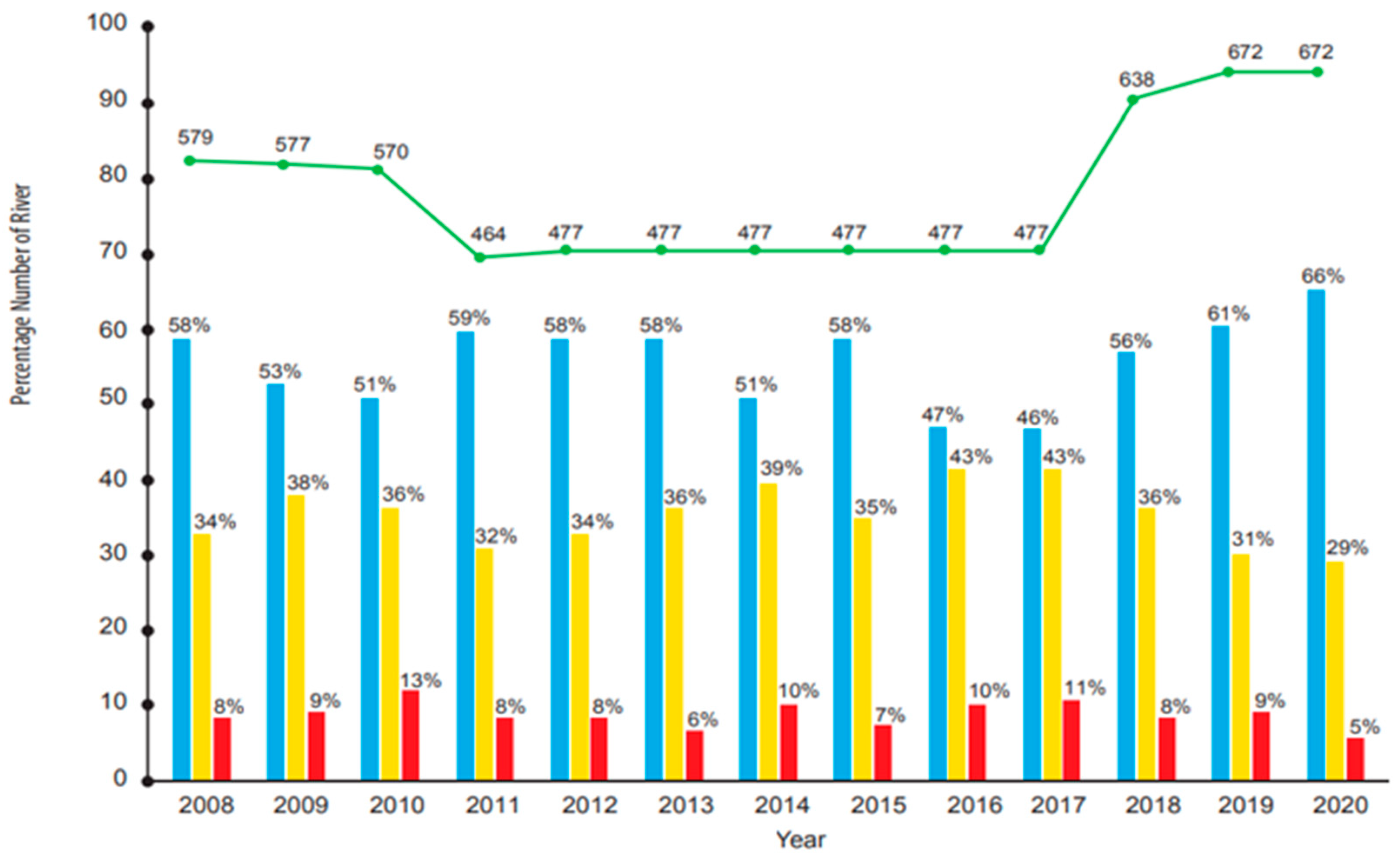


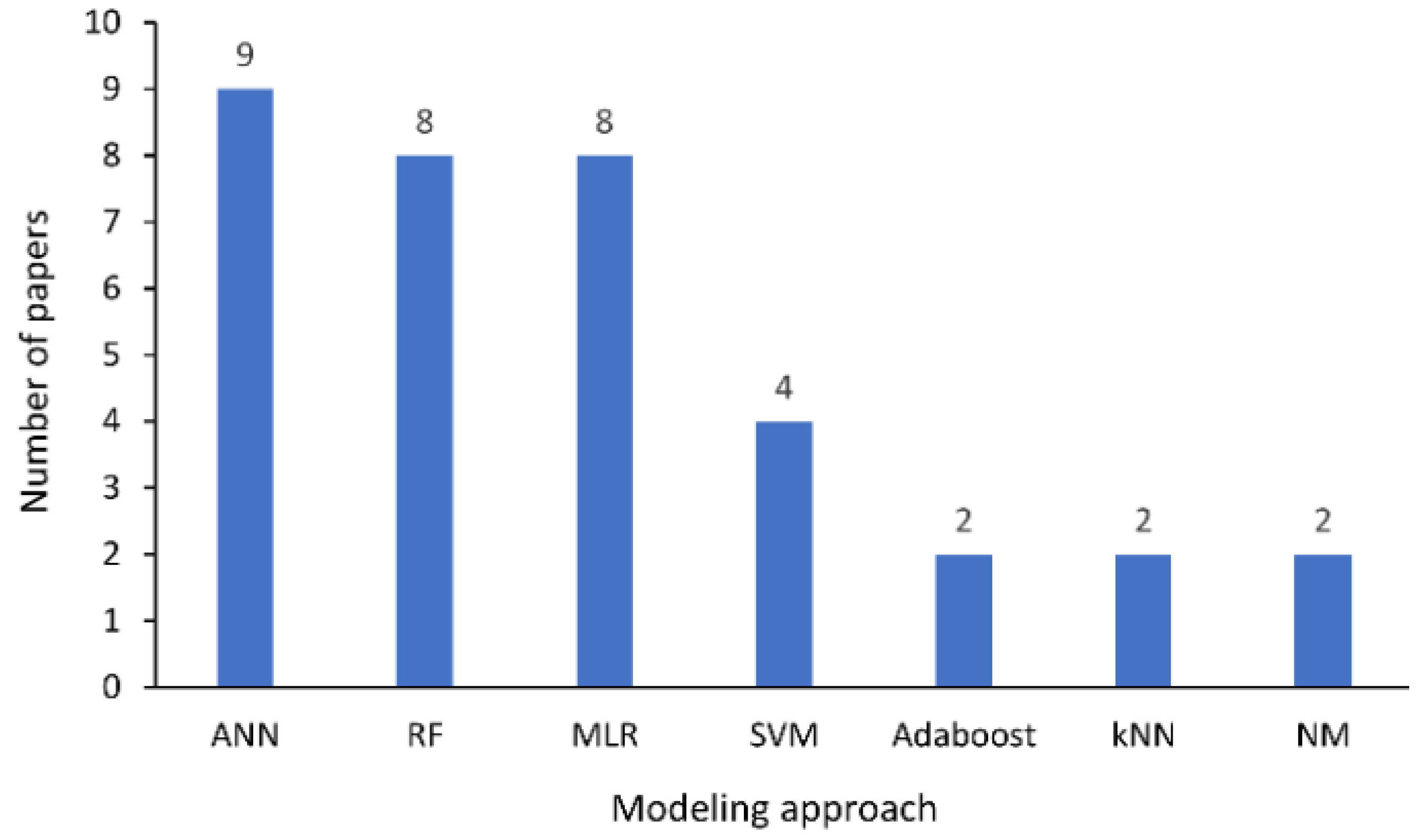
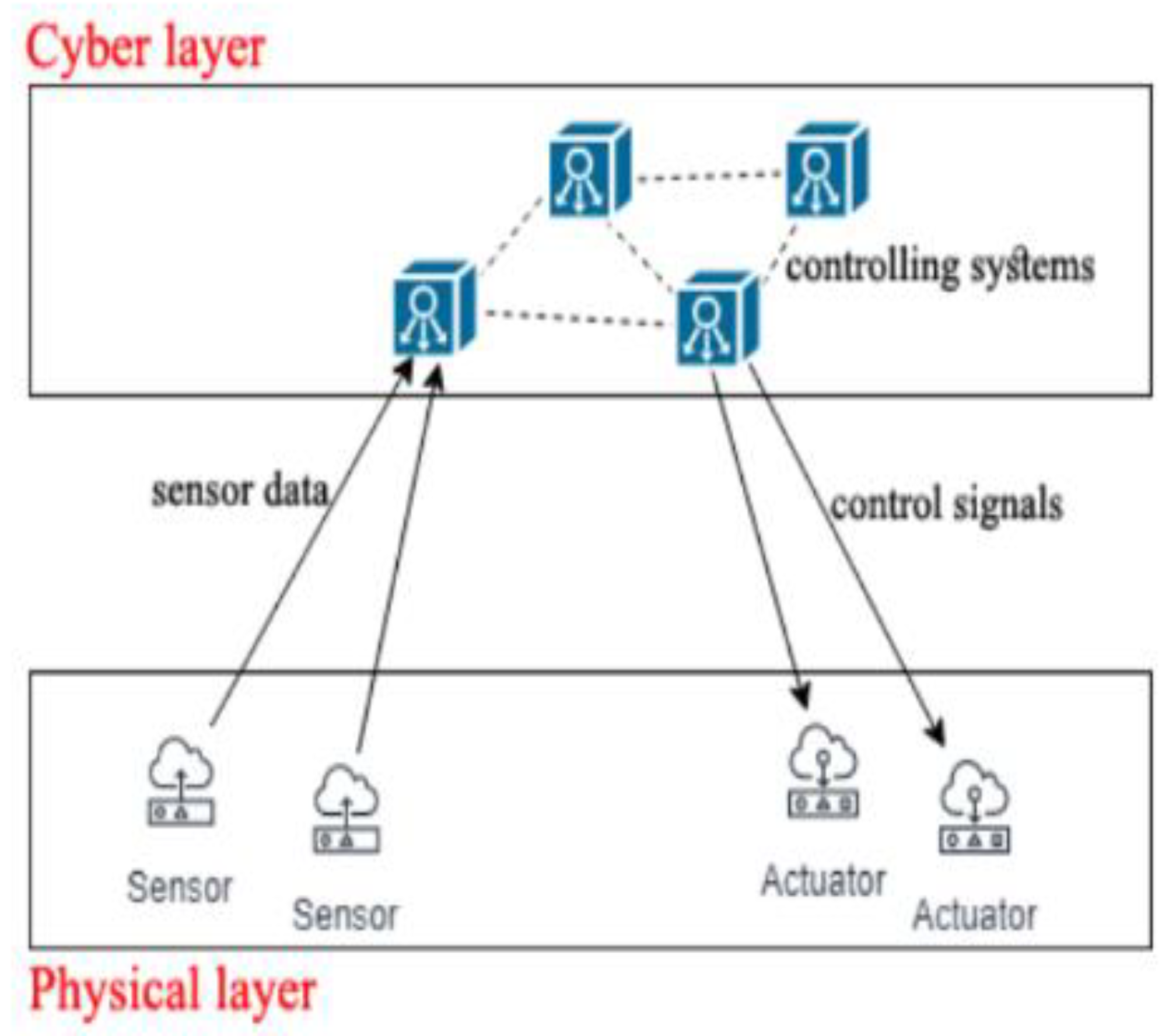
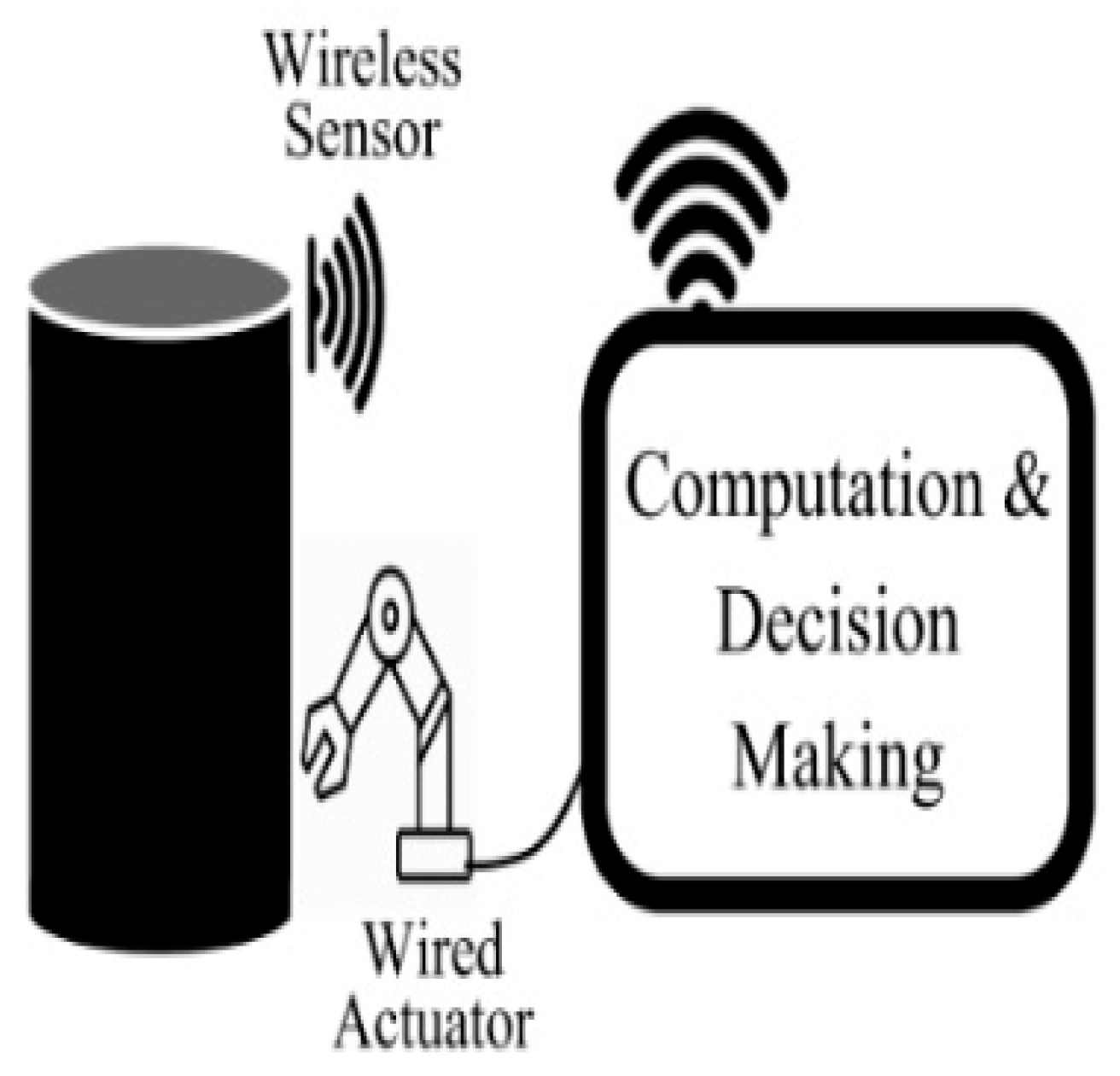
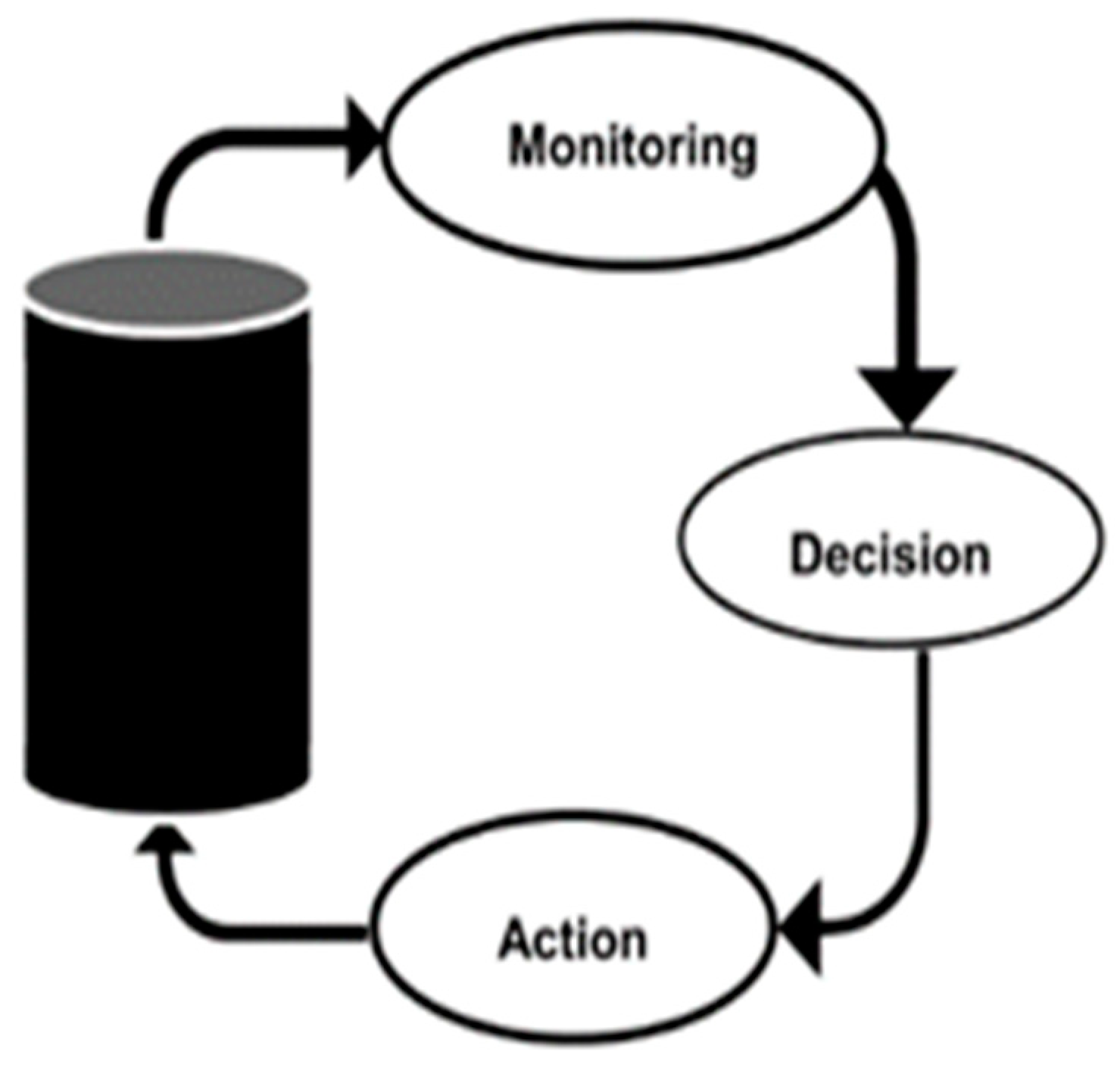
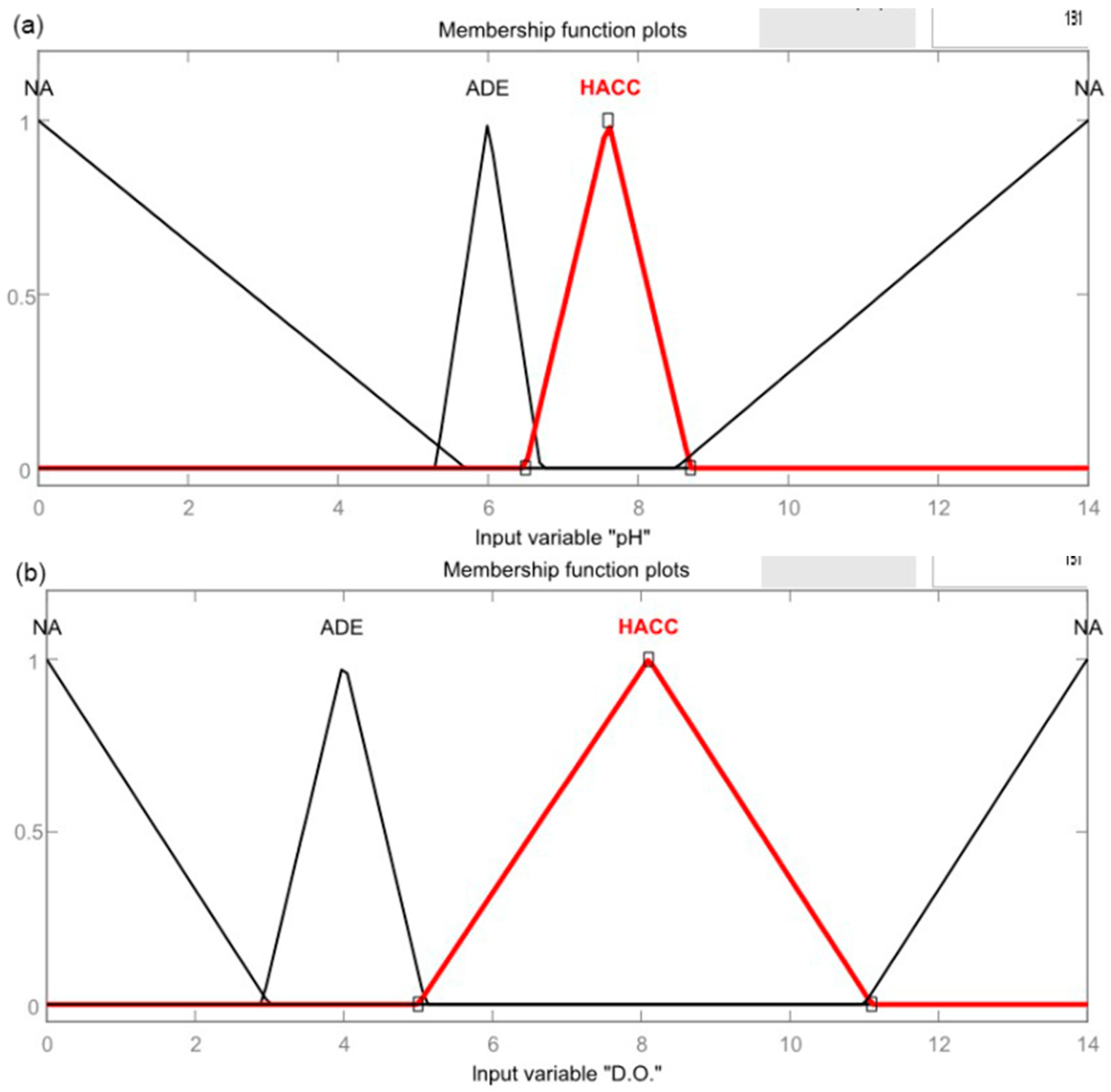

| Chemical Properties | Biological Properties | Physical Properties |
|---|---|---|
| Dissolved oxygen(DO), chemical oxygen demand (COD), biological oxygen demand(BOD) | Bacteria | Turbidity |
| pH level Ammonia Salinity Harness Organic Compounds Metals | Algae Viruses | Temperature Color Taste and Odor Suspended Solids Metals |
| No. | Water Quality Monitoring Method | Types of Contaminant/Water Quality Parameters | Real-Time Monitoring | References |
|---|---|---|---|---|
| 1. | IoT environment such as Intel Galileo Gen 2 which acted as an interface to obtain data from multiple electronics sensors. | pH, dissolved oxygen concentration, turbidity, and temperature. | Yes | [19] |
| 2. | Supervisory Control and Data Acquisition (SCADA) system was integrated with IoT technology to determine water contaminations, leakage in pipeline and automatic measure of several water parameters with Global System for Mobile Communication (GSM) module. | Temperature, color, turbidiy. | Yes | [20] |
| 3. | Real-time bacteria sensor to detect four different types of specified water pollution locations. The result was compared with laboratory analysis. It demonstrates the benefit of the bacteria sensor over turbidity sensors in monitoring bacteria in drinking water as early warning of microbiological pollutions. | Bacteria or abiotic particles. | Yes | [21] |
| 4. | Several technologies for water quality monitoring such as discontinuous sample-based methods for biological and non-biological contaminants. Then, for in-line sensor monitoring, there are sensor placement approach, microfluidic sensors, and spectroscopic techniques. | Biological: Escherichia coli (E. coli), Intestinal enterococci. Chemical: aldicarb, glyphosate, colchicines and nicotine. Physical: temperature, conductivity, pH, ORP and turbidity simultaneously. | No | [22] |
| 5. | Near Infrared (NIR) reflectance spectroscopy to predict water quality in Aceh River based on salinity and total dissolved solids. | Total dissolved solids | No | [23] |
| 6. | Toxicity tests to detect chemical contaminants specifically toxic and adenosine triphosphate (ATP) level method to indicate contaminants by microorganisms. | Toxicity level and microorganisms. | No | [24] |
| 7. | IoT technology development such as ThingSpeak to monitor the water quality. Data from multiple sensors which are connected to Arduino is sent to cloud using ThingSpeak. | pH value, turbidity, level of water in the tank, temperature, and humidity. | Yes | [25] |
| 8. | A rapid Ultraviolet (UV)/Visible (UV-Vis) spectroscopy method for water quality monitoring and the water is sourced from on-farm root vegetable washing processes. The measurement is based on UV-VIS absorbance and used statistical methods such as principal component analysis (PCA) and partial least squares (PLS) regression. | Physical: Suspended solids, pH, BOD, COD, color dilution. Chemical: Organic substances, nitrogen, phosphorus Biological: E.coli, coliform bacteria pathogenic microorganisms | No | [26] |
| 9. | Biological and chemical contaminants in water where polymerase chain reaction (PCR) is a suitable method for bacteria detection in water samples, based on extraction and replication of deoxyribonucleic acid (DNA) fragment samples. | Microorganisms and viruses. | Yes | [24] |
| 10. | IoT based system in water monitoring by adding LEDs. The LEDs lighted up depending on the range of water quality that was detected by several sensors. The system was connected to Raspberry Pi, programmed with Java. | pH, turbidity, chlorine, nitrate, and electrical conductivity. | Yes | [27] |
| 11. | Surface-enhanced Raman Scattering (SERS) as new modern bacteria detection method, based on ultrasensitive vibrational spectroscopy in surface and water waters. | Bacteria | No | [28] |
| 12. | An efficient bacterial rapid detection using laser-induced fluorescence (LIF) spectroscopy technology based on the fluorescence intensity ratio (FIR) and fluorescence intensity to retrieve the bacteria concentrations. | Bacteria: E.coli, K.pneumonia, S.aureus | Yes | [29] |
| 13. | A wireless multi-sensor system by integrating the temperature, pH, DO, and EC sensors with an ESP32 Wi-Fi module platform to monitor water quality of freshwater aquaculture. The estimated salinity level is by EC level sensing data. | Temperature, pH, DO, electrical conductivity (EC), salinity level | Yes | [30] |
| 14. | A multi-source transfer learning (MSTL) for water quality prediction and effectively used water quality information of multiple nearby monitoring points to improve the water prediction accuracy and reduce bias. | Water quality information such as DO, phosphate, water temperature, nitrite | Yes | [31] |
| 15. | Virtual sensing system feasibility from physical sensor methods for water quality assessment and focused on the water use for agricultural purposes. | pH, turbidity, temperature, conductivity, DO, total phosphorus | Yes | [32] |
| 16. | Various effective water quality monitoring system (WQSN) for fishponds using IoT and underwater sensors to record the parameter values continuously in the regular time interval using Arduino/Raspberry Pi board. | pH, DO, nitrogen, ammonia, temperature | Yes | [33] |
| 17. | An online UV-Vis Spectrophotometer for drinking water quality monitoring and process control. The approach is reagent-free, does not require sample pre-treatments and can provide continuous and reliable water parameter measurement with quicker response compared to conventional techniques. | Color, dissolved organic carbon (DOC), total organic carbon (TOC), turbidity, nitrate | Yes | [34] |
| Parameters | NA | ADE | HACC | NA |
|---|---|---|---|---|
| pH | <5.7 | 5.3–6.7 | 6.5–8.7 | >8.5 |
| Dissolved oxygen | <3 | 2.9–5.1 | 5.1–11.1 | >11 |
| Electrical conductivity | <300 | 290–510 | 500–1050 | >1000 |
| Oxygen reduction potential | <550 | 530–670 | 650–820 | >800 |
| Temperature | <2 | 1.9–10 | 9–36 | >35 |
Publisher’s Note: MDPI stays neutral with regard to jurisdictional claims in published maps and institutional affiliations. |
© 2022 by the authors. Licensee MDPI, Basel, Switzerland. This article is an open access article distributed under the terms and conditions of the Creative Commons Attribution (CC BY) license (https://creativecommons.org/licenses/by/4.0/).
Share and Cite
Zainurin, S.N.; Wan Ismail, W.Z.; Mahamud, S.N.I.; Ismail, I.; Jamaludin, J.; Ariffin, K.N.Z.; Wan Ahmad Kamil, W.M. Advancements in Monitoring Water Quality Based on Various Sensing Methods: A Systematic Review. Int. J. Environ. Res. Public Health 2022, 19, 14080. https://doi.org/10.3390/ijerph192114080
Zainurin SN, Wan Ismail WZ, Mahamud SNI, Ismail I, Jamaludin J, Ariffin KNZ, Wan Ahmad Kamil WM. Advancements in Monitoring Water Quality Based on Various Sensing Methods: A Systematic Review. International Journal of Environmental Research and Public Health. 2022; 19(21):14080. https://doi.org/10.3390/ijerph192114080
Chicago/Turabian StyleZainurin, Siti Nadhirah, Wan Zakiah Wan Ismail, Siti Nurul Iman Mahamud, Irneza Ismail, Juliza Jamaludin, Khairul Nabilah Zainul Ariffin, and Wan Maryam Wan Ahmad Kamil. 2022. "Advancements in Monitoring Water Quality Based on Various Sensing Methods: A Systematic Review" International Journal of Environmental Research and Public Health 19, no. 21: 14080. https://doi.org/10.3390/ijerph192114080
APA StyleZainurin, S. N., Wan Ismail, W. Z., Mahamud, S. N. I., Ismail, I., Jamaludin, J., Ariffin, K. N. Z., & Wan Ahmad Kamil, W. M. (2022). Advancements in Monitoring Water Quality Based on Various Sensing Methods: A Systematic Review. International Journal of Environmental Research and Public Health, 19(21), 14080. https://doi.org/10.3390/ijerph192114080






